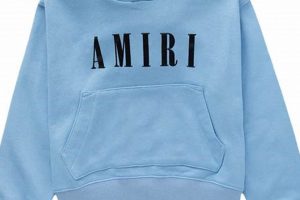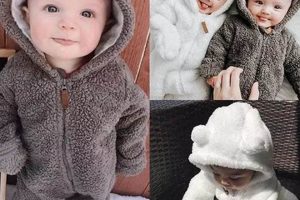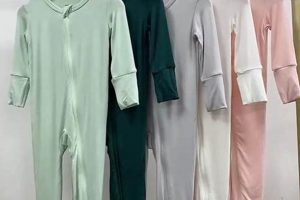Garments designed for infants and small children, focusing on gentle materials and compassionate manufacturing processes, represent a growing sector within the apparel industry. This category of clothing prioritizes the comfort and well-being of the child, as well as ethical and sustainable production methods. For example, outfits crafted from organic cotton, using low-impact dyes, fall under this classification.
The significance of selecting appropriate attire for babies lies in safeguarding their sensitive skin and promoting healthy development. Soft, breathable fabrics minimize the risk of irritation and allergic reactions. Furthermore, responsible production practices contribute to environmental preservation and fair labor standards, reflecting a commitment to both the child’s welfare and global well-being. Historically, advancements in textile technology and increased consumer awareness have fueled the demand for options that are both gentle and ethically produced.
The subsequent sections will delve into specific aspects of this clothing category, examining material choices, manufacturing considerations, and consumer trends that shape the current landscape. This will provide a comprehensive understanding of the attributes and factors that define high-quality, ethically sourced items for infants and toddlers.
Guidance on Selecting Infant Apparel with Gentle Qualities
This section offers practical advice for choosing baby clothing that prioritizes both comfort and ethical production. Careful consideration of materials, construction, and sourcing can significantly impact an infant’s well-being and support responsible manufacturing practices.
Tip 1: Prioritize Natural Fibers. Opt for materials such as organic cotton, bamboo, or merino wool. These fibers are inherently breathable and less likely to cause skin irritation compared to synthetic alternatives.
Tip 2: Examine Seam Construction. Look for garments with flat seams or external seams to minimize rubbing and pressure points against the baby’s delicate skin.
Tip 3: Consider Dye Composition. Choose clothing colored with low-impact, non-toxic dyes. These dyes reduce the risk of allergic reactions and are environmentally responsible.
Tip 4: Assess Fastener Security. Ensure that snaps, zippers, or buttons are securely attached and free from sharp edges. Avoid drawstrings or other features that could pose a choking hazard.
Tip 5: Evaluate Garment Sizing. Select clothing that allows for freedom of movement and accommodates diaper changes. Avoid overly tight or restrictive garments, which can hinder circulation.
Tip 6: Verify Ethical Sourcing. Seek out brands that transparently disclose their manufacturing processes and adhere to fair labor standards. Certifications such as Fair Trade or GOTS (Global Organic Textile Standard) can provide assurance of ethical production.
Tip 7: Minimize Embellishments. Reduce the presence of unnecessary decorations, such as beads, sequins, or appliques, which could detach and pose a choking hazard. Simplicity promotes both safety and comfort.
Selecting baby clothing with mindful consideration of these factors contributes to an infant’s comfort and supports ethical practices in the apparel industry. These choices promote both individual well-being and a more sustainable future.
The following section will explore common misconceptions and address frequently asked questions regarding infant apparel selection, further solidifying the importance of informed decision-making.
1. Material Gentleness
The concept of “Material Gentleness” forms a foundational pillar in the realm of apparel designed for infants and young children. The direct correlation between the fabrics used and the comfort, health, and well-being of the child cannot be overstated. Specifically, materials that prioritize softness, breathability, and hypoallergenic properties are essential in mitigating potential skin irritations, allergic reactions, and discomfort. The selection of harsh or synthetic fabrics, conversely, can lead to dermatitis, eczema flare-ups, and general distress in infants, whose skin is significantly more sensitive than that of adults. For instance, garments crafted from conventionally grown cotton often contain pesticide residues that can trigger adverse reactions in vulnerable individuals. Conversely, clothing made from organic cotton, bamboo, or merino wool minimizes these risks, providing a safer and more comfortable alternative.
The importance of “Material Gentleness” extends beyond mere comfort; it impacts the overall development and well-being of infants. Constant skin irritation can disrupt sleep patterns, lead to increased fussiness, and potentially hinder developmental milestones. Furthermore, the use of breathable fabrics, such as those mentioned above, aids in temperature regulation, reducing the risk of overheating or chilling, both of which can be detrimental to infants. Real-life examples of this principle at work are abundant. Parents who switch from synthetic-based clothing to natural-fiber alternatives often report a marked improvement in their child’s skin condition and overall temperament. The practical significance of understanding this connection lies in empowering consumers to make informed choices that prioritize their child’s health and well-being.
In summary, the selection of gentle materials is not merely a cosmetic consideration in infant apparel, but rather a critical determinant of a child’s comfort, health, and developmental progress. While challenges may exist in identifying and accessing truly gentle and ethically sourced fabrics, the potential benefits for both the child and the environment far outweigh the difficulties. The emphasis on “Material Gentleness” underscores the broader need for a more conscientious and responsible approach to clothing production and consumption, particularly when it comes to vulnerable populations. Recognizing this relationship allows for thoughtful purchasing decisions, reinforcing the idea that clothing can be a catalyst for care and well-being.
2. Ethical Production
Ethical production, in the context of apparel designed for infants and young children, refers to manufacturing processes that prioritize fair labor practices, environmental sustainability, and transparency throughout the supply chain. Its connection to items meant to be gentle and kind is intrinsic; the very essence of creating such items dictates a responsibility to minimize harm in every stage, from raw material acquisition to finished product disposal. A focus on “Ethical Production” is not merely a marketing tactic, but a fundamental element contributing to the overall integrity and value of the garments. Cause and effect are demonstrably linked: exploitative labor practices generate lower costs, but at the expense of human dignity, while environmentally damaging processes may reduce expenses but simultaneously inflict harm on the planet that infants will inherit. Therefore, products that are truly gentle and kind must, by definition, be produced ethically.
Real-life examples underscore the importance of this connection. Consider the case of organic cotton farming. When cultivated ethically, without the use of harmful pesticides or genetically modified seeds, it protects the health of farmers, the environment, and ultimately, the infants who wear clothing made from this cotton. Conversely, non-organic cotton production often involves harsh chemicals that can contaminate water sources and pose health risks to agricultural workers. Similarly, fair labor practices ensure that garment workers receive fair wages, safe working conditions, and the opportunity to support their families with dignity. Brands that prioritize ethical production often implement rigorous auditing processes to ensure compliance with labor standards and environmental regulations. These practices enhance product quality and build consumer trust.
The practical significance of understanding this link lies in empowering consumers to make informed purchasing decisions. By actively seeking out brands that are transparent about their supply chains and committed to ethical production practices, consumers can directly support a more sustainable and just apparel industry. Challenges persist, as discerning ethically produced garments requires diligent research and may involve a higher price point. However, the benefits extend beyond the individual child, contributing to a more equitable and environmentally sound global community. Ultimately, a commitment to ethical production aligns seamlessly with the goal of creating apparel that is genuinely kind and gentle, fostering a culture of responsibility within the apparel industry and consumer awareness.
3. Size Appropriateness
The dimension of Size Appropriateness is a critical factor when considering garments for infants. Ensuring proper fit directly impacts the child’s comfort, safety, and physical development, aligning intrinsically with the principles of providing gentle and kind apparel.
- Freedom of Movement
Clothing that is correctly sized allows for unrestricted movement, crucial for infants exploring their environment and developing motor skills. Garments that are too tight can constrict movement, hindering development. Conversely, excessively large clothing may pose a tripping hazard or become entangled, potentially leading to injury.
- Temperature Regulation
Size impacts a garment’s ability to regulate body temperature. Overly snug clothing can impede air circulation, increasing the risk of overheating, while excessively loose garments may not provide sufficient insulation in cooler environments. Proper sizing ensures optimal breathability and warmth as needed.
- Diaper Accommodation
Infant apparel must accommodate diapers without causing discomfort or restriction. Properly sized garments include sufficient room in the diaper area to prevent chafing or pressure points. Incorrect sizing in this area can lead to skin irritation and discomfort.
- Safety Considerations
Poorly sized clothing can present safety hazards. Loose strings, ribbons, or excessively long sleeves or pant legs can become entanglement risks, especially during sleep. Secure, well-fitting garments minimize these potential dangers.
Therefore, careful attention to size ensures that infant apparel provides comfort, supports healthy development, and minimizes safety hazards. The selection of correctly sized items is a fundamental aspect of providing genuinely kind and gentle care for infants.
4. Dye Safety
The safety of dyes used in infant apparel is a paramount concern, directly impacting the well-being of the wearer. The sensitivity of an infant’s skin necessitates stringent evaluation of dye compositions to mitigate potential adverse reactions. The connection between “Dye Safety” and the principles of gentleness and kindness inherent in this type of clothing is evident.
- Composition of Dyes
The chemical makeup of dyes determines their safety profile. Dyes containing heavy metals, formaldehyde, or aromatic amines pose significant risks. These substances can leach from the fabric and be absorbed through the skin, leading to allergic reactions, skin irritation, or even more severe health complications. For example, azo dyes, commonly used for vibrant colors, can release carcinogenic aromatic amines. Conversely, natural dyes derived from plants or minerals, and low-impact synthetic dyes formulated to minimize environmental impact, generally present lower risks. Certifications such as Oeko-Tex Standard 100 verify that textiles are free from harmful substances, including specific dyes.
- Absorption and Irritation
Infant skin is thinner and more permeable than adult skin, making it more susceptible to absorbing chemicals. Dyes that cause contact dermatitis or allergic reactions can lead to skin rashes, itching, and discomfort. The effects of dye exposure are amplified in infants due to their underdeveloped detoxification systems. Garments that come into direct and prolonged contact with the skin, such as bodysuits and sleepwear, require particular scrutiny. The use of dye-free or minimally dyed fabrics can significantly reduce the risk of irritation in sensitive individuals.
- Environmental Impact
The production of dyes can have significant environmental consequences. Traditional dye manufacturing often involves the release of pollutants into waterways, contaminating ecosystems and posing health risks to communities near production facilities. Sustainable dye practices prioritize water conservation, waste reduction, and the use of less toxic chemicals. For example, reactive dyes, while synthetic, bond permanently to the fabric, reducing dye runoff during washing. Choosing garments dyed using environmentally responsible methods contributes to a more sustainable apparel industry.
- Testing and Certification
Rigorous testing and certification processes are essential for ensuring dye safety. Independent laboratories conduct tests to detect the presence of harmful substances in textiles. Certifications such as GOTS (Global Organic Textile Standard) require that all dyes used in organic textiles meet stringent environmental and toxicological criteria. Consumers can rely on these certifications to identify products that have been independently verified as safe and free from harmful chemicals. Brands committed to dye safety often provide detailed information about their dye sources and testing procedures.
In summary, “Dye Safety” is integral to the concept of apparel designed with gentleness and kindness in mind. Careful consideration of dye composition, potential for absorption and irritation, environmental impact, and the availability of testing and certification are crucial for safeguarding the health and well-being of infants. The conscientious selection of garments dyed using safe and sustainable practices represents a tangible commitment to both individual and environmental health, supporting a more responsible approach to clothing production and consumption.
5. Seam Comfort
Seam comfort constitutes a crucial yet often overlooked element in garments designed for infants and young children. The direct contact of seams with an infant’s sensitive skin necessitates careful construction techniques to minimize irritation and discomfort. The causal relationship is clear: poorly constructed seams can lead to chafing, pressure marks, and even skin breakdown, particularly in areas where seams are concentrated, such as the armpits, neckline, and diaper region. The importance of seam comfort as a component of apparel intended to be gentle and kind cannot be overstated; it directly impacts the child’s well-being and reflects the manufacturer’s commitment to quality and care. For instance, garments with exposed, bulky seams can cause significant distress for infants, leading to restlessness and crying. Conversely, items featuring flatlock seams or external seams, where the stitching is placed on the outside of the garment, significantly reduce the risk of irritation. This understanding has practical significance, enabling parents and caregivers to make informed purchasing decisions that prioritize the child’s comfort.
Practical applications of seam comfort considerations extend beyond the choice of seam type. Careful attention to thread selection, seam placement, and garment construction techniques all contribute to minimizing potential sources of irritation. Soft, flexible threads are preferable to rigid or coarse threads, as they are less likely to cause friction against the skin. Strategic seam placement, such as avoiding seams directly under the arms or around the neck, can further reduce the risk of discomfort. Manufacturers committed to seam comfort often employ techniques such as taping seams to prevent fraying or reinforcing seams with soft, fabric strips to create a barrier between the seam and the skin. Real-world examples include brands that utilize blind stitching, where the stitches are hidden within the fabric layers, resulting in a smooth, seamless interior. These approaches demonstrate a comprehensive understanding of the factors that contribute to seam comfort and a dedication to producing apparel that is truly gentle and kind.
In conclusion, seam comfort is an indispensable element in garments designed for infants. Addressing this aspect requires a holistic approach, encompassing careful selection of seam types, thread materials, seam placement, and construction techniques. While the specific methods may vary, the underlying principle remains constant: minimizing potential sources of irritation to ensure the child’s comfort and well-being. Challenges may arise in discerning seam quality through visual inspection alone, necessitating reliance on reputable brands that prioritize transparency and craftsmanship. Ultimately, the emphasis on seam comfort underscores the broader theme of responsible apparel production, reinforcing the importance of prioritizing the needs and sensitivities of the most vulnerable consumers.
6. Durability
Durability, in the context of apparel for infants, extends beyond mere longevity; it encompasses the ability of garments to withstand frequent washing, wear, and the rigors of daily use without compromising safety, comfort, or the integrity of materials. The connection between durability and items meant to be gentle and kind is critical, as it directly impacts the long-term value, sustainability, and overall safety of the products. It is vital that these items stand up to regular cleaning and use because infant clothing is subjected to frequent cleaning.
- Fabric Integrity
The choice of fabric significantly impacts garment durability. Natural fibers like organic cotton, bamboo, and linen, when woven or knitted with a tight construction, offer enhanced resistance to wear and tear. Synthetic blends, while sometimes increasing resilience, may compromise the breathability and gentleness essential for infant skin. Examples include organic cotton interlock knits, known for their softness and ability to retain shape after multiple washes. The implications for “tiny kind baby clothes” are that selecting high-quality, durable fabrics ensures that the garments maintain their intended properties, such as softness and shape, even after repeated laundering.
- Seam Strength
Seam construction is a crucial determinant of durability. Reinforced seams, double stitching, and the use of durable threads contribute to the garment’s ability to withstand stress at points of connection. Weak seams are prone to tearing, rendering the garment unusable and potentially posing a safety hazard if fasteners detach. An example would be flatlock seams used on many baby items that not only are comfortable against sensitive skin, but provide a more sturdy seam. The importance here is that seam integrity ensures the clothing remains intact and functional throughout its intended lifespan, preventing premature disposal and reducing waste.
- Colorfastness and Shape Retention
Durable dyes and pre-shrunk fabrics are essential for maintaining the garment’s appearance and fit over time. Dyes that fade or bleed with washing can diminish the garment’s aesthetic appeal and potentially transfer onto other items. Similarly, fabrics that shrink excessively can render the garment unwearable. Using natural dyes that are more robust ensures less wear and tear on baby items. This ensures that clothes will have more resilience.
- Fastener Resilience
Snaps, zippers, and buttons are integral components of infant apparel, and their durability is crucial for garment functionality and safety. Fasteners that detach easily can pose a choking hazard, while those that break or become loose can render the garment unusable. Look for reinforced fasteners that are guaranteed to last to ensure the longevity of these pieces. The importance here is that the clothes will be less likely to have wear and tear, and be easily replaceable to keep the clothes going for longer.
The facets above highlight the interdependence of material selection, construction techniques, and component quality in determining garment durability. When considering garments intended to be gentle and kind, durability becomes more than just a measure of longevity; it reflects a commitment to sustainability, safety, and providing lasting value. These facets ensures baby items will be worn and used more.
Frequently Asked Questions
The following addresses common inquiries and concerns regarding the selection and care of infant apparel designed to be gentle on delicate skin and produced through ethical means.
Question 1: What constitutes “gentle” material in the context of infant clothing?
Gentle materials are characterized by their softness, breathability, and hypoallergenic properties. Typically, this includes organic cotton, bamboo viscose, merino wool, and other natural fibers cultivated and processed without harsh chemicals or dyes. These materials minimize the risk of skin irritation, allergic reactions, and discomfort in infants.
Question 2: How can consumers verify that infant clothing is ethically produced?
Verification involves seeking out certifications such as Fair Trade, GOTS (Global Organic Textile Standard), or OEKO-TEX Standard 100, which indicate compliance with specific labor and environmental standards. Additionally, transparency in a brand’s supply chain, including information on manufacturing processes and worker welfare, can offer further assurance of ethical production.
Question 3: Why is size appropriateness especially critical for infant garments?
Size appropriateness is paramount because ill-fitting clothing can impede movement, hinder proper temperature regulation, and even pose safety hazards. Garments that are too tight can restrict circulation and cause chafing, while those that are too loose can become entanglement risks. Correct sizing allows for comfortable diapering and unrestricted exploration.
Question 4: What risks are associated with dyes used in infant clothing, and how can these risks be mitigated?
Dyes containing heavy metals, formaldehyde, or aromatic amines can cause skin irritation, allergic reactions, and potential long-term health problems. These risks can be mitigated by choosing garments dyed with low-impact, non-toxic dyes or opting for naturally colored or undyed fabrics. Certifications such as OEKO-TEX Standard 100 guarantee that textiles are free from harmful dye substances.
Question 5: What seam construction techniques minimize discomfort for infants?
Techniques such as flatlock seams, which lie flat against the skin, and external seams, where the stitching is placed on the outside of the garment, are designed to minimize friction and pressure points. Soft, flexible threads and strategic seam placement, avoiding areas of high sensitivity, further contribute to seam comfort.
Question 6: How can the durability of infant clothing be assessed and maintained?
Durability can be assessed by examining the quality of the fabric, seam construction, and fastener attachments. Maintenance involves following care instructions carefully, washing garments in cold water with gentle detergents, and avoiding harsh chemicals or excessive heat during drying. Proper care extends the lifespan of the garments and preserves their safety and comfort.
In summary, the selection and care of infant apparel require careful consideration of material composition, ethical production practices, sizing, dye safety, seam construction, and durability. Informed decisions based on these factors contribute to the well-being of the child and support a more sustainable and responsible apparel industry.
The following section will explore actionable steps individuals can take to promote and support responsible practices within the infant apparel market, encouraging wider adoption of standards that benefit both children and the environment.
tiny kind baby clothes
This examination of garments for infants, emphasizing gentle materials and ethical production, reveals interconnected priorities. The choice of fabrics, manufacturing processes, size considerations, dye safety, seam construction, and durability each contribute to the overall quality and suitability of these items. Prioritizing these factors translates to tangible benefits for the child’s well-being and the environment.
Continued vigilance and informed purchasing decisions are vital in fostering a market that values both human health and ecological sustainability. A sustained commitment to responsible practices will drive innovation and ensure that garments intended for the most vulnerable individuals are created with the utmost care and integrity.


![[Guide] Smart Grow With Me Baby Clothes Savings Tips Baby Care 101: Essential Tips for Happy, Healthy Babies [Guide] Smart Grow With Me Baby Clothes Savings Tips | Baby Care 101: Essential Tips for Happy, Healthy Babies](https://singlebabies.com/wp-content/uploads/2025/10/th-970-300x200.jpg)




